相关性分析:
-
King Afonso I 和 Queen Nzinga
这两位领导者都在葡萄牙殖民扩张期间对抗过欧洲的殖民主义者,尤其是在非洲。King Afonso I(阿丰索一世)是刚果王国的国王,他在16世纪初期与葡萄牙建立了外交和商业关系,但最终对葡萄牙的奴隶贸易及其对刚果的干预感到不满,导致了他与葡萄牙的冲突。Queen Nzinga(恩金扎女王)则是安哥拉的统治者,她领导了对抗葡萄牙的长期抵抗运动,尤其是在安哥拉的恩东戈王国。这两位领导者都深受葡萄牙殖民活动的影响,并且采取了不同的方式回应葡萄牙的干预。 -
Antonian Movement 和 King Afonso I
Antonian Movement(安托尼亚运动)是由一位刚果女性安托尼亚领导的宗教和政治运动,旨在反对葡萄牙的影响。这个运动与King Afonso I直接相关,因为这场运动本质上是对他领导下的与葡萄牙合作的政策的反叛。安托尼亚认为葡萄牙殖民者并未真正关心刚果人民的福祉,因而在宗教上推广了更为本土的信仰,挑战了葡萄牙强加的天主教。 -
Triangular Trade 和 Middle Passage
Triangular Trade(三角贸易)与Middle Passage(中途航程)是直接相关的。Triangular Trade是指欧洲、非洲和美洲之间的贸易路线,其中包括了从非洲向美洲运输奴隶的部分,即Middle Passage。这是三角贸易中的一段历史性航程,它描述了奴隶被从非洲运送到美洲的过程,通常条件极为艰苦,奴隶在这段航程中遭受了极大的痛苦。

幻灯片 1: 这张幻灯片展示了跨大西洋奴隶贸易的三角贸易路线。简单来说,三角贸易指的是欧洲、非洲和美洲之间的商品和奴隶交换。美洲向欧洲出口糖、烟草和棉花;非洲则将奴隶运送到美洲;而欧洲则向非洲出口纺织品、朗姆酒和其他制造商品。
从专业角度来看,这个三角贸易体系不仅仅是经济交换,它实际上促进了全球资本主义的起步,尤其是在跨大西洋奴隶贸易的背景下。美洲的农场经济依赖于廉价的非洲奴隶劳动力,而欧洲通过这种贸易获得了原材料、劳动力和财富,这些都为工业革命和现代西方经济体系的形成奠定了基础。
Slide 1: This slide illustrates the triangular trade route during the Transatlantic Slave Trade period. Simply put, the triangular trade refers to the exchange of goods and slaves between Europe, Africa, and the Americas. The Americas sent sugar, tobacco, and cotton to Europe, while slaves were transported from Africa to the Americas, and Europe exported textiles, rum, and manufactured goods to Africa.
On a more professional level, the triangular trade system was not just an economic exchange; it actually facilitated the rise of global capitalism, especially in the context of the Transatlantic slave trade. The plantation economy in the Americas heavily relied on cheap African slave labor, while Europe gained raw materials, labor, and wealth through this exchange. These factors played a significant role in the formation of the Industrial Revolution and the modern Western economic system.
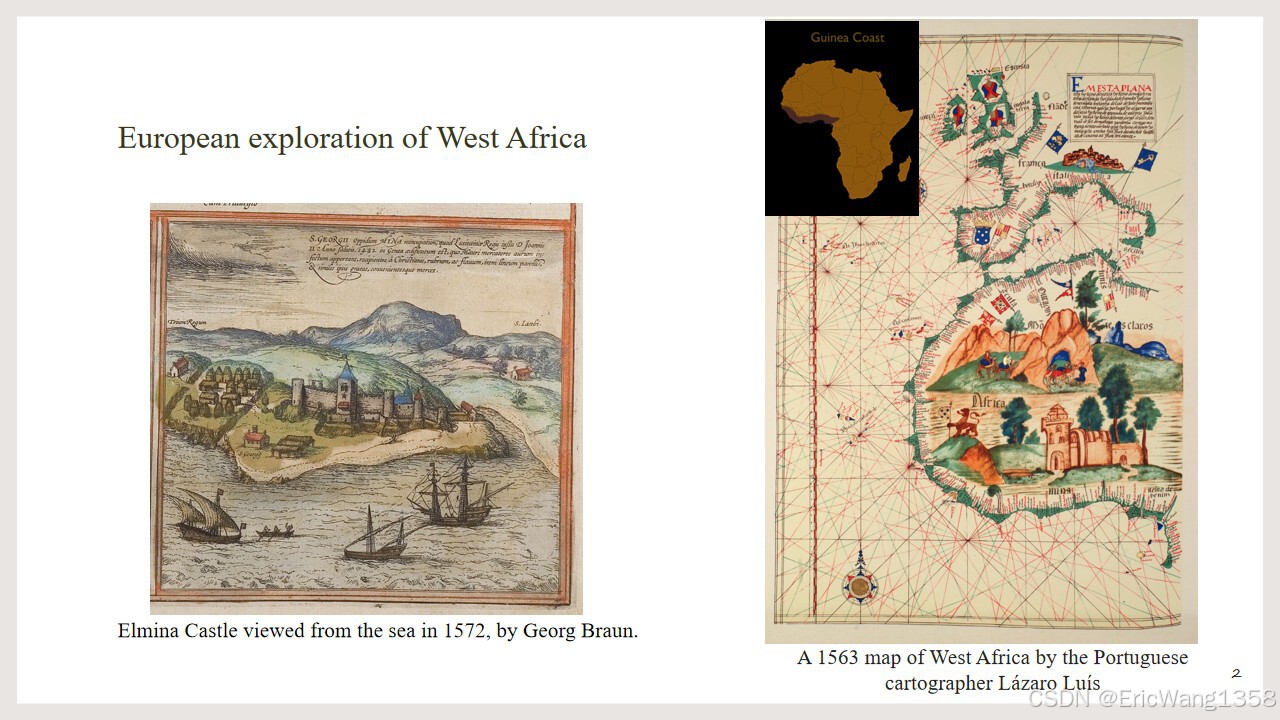
幻灯片 2: 这一张幻灯片展示了欧洲对西非的探索,重点是16世纪。通俗来说,16世纪时,欧洲开始加大对西非的关注和探索,特别是葡萄牙人和西班牙人的活动。左侧的图像是1572年从海上看到的埃尔米纳城堡,它象征着葡萄牙在非洲的殖民扩展。而右侧的地图则描绘了葡萄牙商人如何通过海上航线探索和控制西非的黄金和奴隶贸易。
从专业的角度来看,欧洲对西非的探索并不仅仅是为了获取黄金,它标志着葡萄牙和其他欧洲国家开始在非洲沿海建立商贸网络。这些网络不仅改变了当地的贸易格局,还开启了欧洲殖民帝国的扩张时代,为后来的大西洋奴隶贸易和资源掠夺提供了基础。
Slide 2: This slide focuses on European exploration of West Africa, especially in the 16th century. Simply put, during this time, Europe, particularly the Portuguese and Spanish, increased their exploration and involvement in West Africa. The left image shows Elmina Castle in 1572, viewed from the sea, symbolizing Portugal's colonial expansion in Africa. The right map depicts how Portuguese merchants explored and controlled the gold and slave trade along the West African coast.
From a professional perspective, European exploration of West Africa was not only about acquiring gold; it also marked the beginning of the establishment of trade networks by Portugal and other European countries along the African coastline. These networks not only reshaped local trade dynamics but also laid the groundwork for the expansion of European colonial empires, contributing to the subsequent Atlantic slave trade and resource exploitation.


幻灯片 4: 这一张幻灯片比较了跨撒哈拉贸易和16世纪出现的海上贸易。简单来说,跨撒哈拉贸易在1500年之前是非洲富裕和权力的源泉,它通过沙漠路线将黄金、盐和其他商品从撒哈拉南北连接起来。16世纪的海上贸易则改变了西非的经济格局,将非洲沿海地区与印度洋的商业联系起来。
从专业角度看,跨撒哈拉贸易曾是非洲经济的基础,尤其是在黄金和奴隶贸易方面。然而,随着16世纪海上贸易的发展,非洲的经济中心发生了转移。葡萄牙和其他欧洲列强在非洲建立了贸易站点,这不仅改变了非洲的传统贸易路线,还推动了西非国家向欧洲的商品出口和奴隶运输的增加。
Slide 4: This slide contrasts the Trans-Saharan trade and the maritime trade that emerged in the 16th century. Simply put, the Trans-Saharan trade was the source of wealth and power for African rulers before 1500, connecting the northern and southern parts of the Sahara with the exchange of gold, salt, and other goods. The maritime trade of the 16th century shifted the economic focus of West Africa, linking coastal regions with commercial opportunities in the Indian Ocean.
From a professional perspective, the Trans-Saharan trade had been the backbone of Africa's economy, especially in terms of gold and slave trading. However, with the development of maritime trade in the 16th century, the economic center of Africa shifted. Portugal and other European powers established trading posts along the African coast, which not only altered traditional trade routes but also increased exports from West Africa to Europe, including the transportation of slaves.
跨撒哈拉贸易
跨撒哈拉贸易是指在公元前几世纪到1500年间,通过撒哈拉沙漠的商贸路线,连接北非和撒哈拉以南地区(即西非、中央非洲和东非)之间的商品交换。最重要的贸易商品包括黄金、盐、象牙、奴隶、和其他生活必需品。这个贸易体系促进了不同文化、宗教和技术的交流,是非洲历史上最重要的经济和文化互动之一。
Trans-Saharan Trade
The Trans-Saharan trade refers to the trade routes that connected North Africa and Sub-Saharan Africa (including West, Central, and East Africa) across the Sahara Desert, from ancient times until around the 16th century. The key traded commodities included gold, salt, ivory, slaves, and other essentials. This trade system facilitated cultural, religious, and technological exchanges and was one of the most important economic and cultural interactions in African history.

幻灯片 5: 这一张幻灯片展示了西非和东非的几个重要国家,特别是加纳王国和马里帝国。简单来说,加纳和马里是非洲历史上非常重要的帝国,它们通过控制跨撒哈拉的黄金贸易积累了巨大的财富。加纳王国在公元8到11世纪间处于巅峰,而马里帝国则在公元13到16世纪占据了主导地位。
从专业角度看,这两个帝国不仅在经济上控制了黄金贸易,还通过建立强大的政治和军事制度,维护了在西非的影响力。加纳和马里的财富源于它们对黄金的控制,以及它们与其他地区(特别是北非和中东)的商贸关系。马里帝国的鼎盛时期也为后来的欧洲殖民势力的进入提供了背景。
Slide 5: This slide presents key states in West and East Africa, especially the Kingdom of Ghana and the Mali Empire. Simply put, Ghana and Mali were two highly influential empires in African history. They accumulated immense wealth by controlling the Trans-Saharan gold trade. The Kingdom of Ghana was at its peak from the 8th to the 11th centuries, while the Mali Empire dominated from the 13th to the 16th centuries.
From a professional perspective, both of these empires not only controlled the gold trade economically but also maintained strong political and military systems that secured their influence in West Africa. The wealth of Ghana and Mali came from their control over gold and their trade relationships with other regions, particularly North Africa and the Middle East. The Mali Empire's height also provided the context for the subsequent arrival of European colonial powers.

幻灯片 6:
这张幻灯片介绍了宋海帝国(15世纪至16世纪)。通俗来说,宋海帝国是西非的一大强国,其核心城市是高奥。在15世纪中期,苏尼·阿里通过军事征服巩固了帝国的统治,尤其是对廷布克图和杰内两座重要的贸易城市的控制。宋海帝国以其在黄金和盐的贸易上占据重要地位而闻名,同时也是伊斯兰教传播的重要区域。
从专业角度看,宋海帝国的崛起与其控制的黄金和盐的贸易息息相关,这使得它成为了跨撒哈拉贸易的强国之一。随着伊斯兰教的扩展,宋海帝国也成为了西非文化和宗教交流的重要枢纽。16世纪末期,宋海帝国的衰落与海上贸易的兴起密切相关,这为沿海贸易国家与欧洲商人建立联系铺平了道路。
Slide 6:
This slide introduces the Songhay Empire (15th – 16th centuries). Simply put, the Songhay Empire was a major power in West Africa, with its core city being Gao. In the mid-15th century, Sunni Ali consolidated the empire through military conquests, especially controlling the important trading cities of Timbuktu and Jenne. The empire became a significant trading power, particularly in gold and salt, while also expanding the influence of Islam.
From a professional perspective, the rise of the Songhay Empire was closely tied to its control over the gold and salt trade, making it one of the most influential powers in the Trans-Saharan trade. With the expansion of Islam, the Songhay Empire also became a key hub for cultural and religious exchange in West Africa. The decline of the Songhay Empire in the late 16th century was closely linked to the rise of maritime trade, which paved the way for coastal trading states to establish connections with European merchants.

幻灯片 7:
这张幻灯片展示了15世纪到1650年间的非洲各大国家。通俗来说,我们可以看到宋海帝国、刚果王国和卡内姆-博尔努王国是当时非洲最大的三个国家,地图上用不同的颜色标示了它们的范围。这些国家在地理上具有重要战略位置,并参与了大量的跨大西洋贸易和地区事务。
从专业角度看,宋海帝国(位于西非)和卡内姆-博尔努王国(位于中非)控制了重要的贸易路线,而刚果王国则以其商业联系和与欧洲殖民者的外交交往而著名。地图中的三个大国是当时非洲政治和经济的中心,直接影响着非洲大陆的历史走向。
Slide 7:
This slide shows the major African states between 1500 and 1650. Simply put, we can see that the Songhay Empire, the Kingdom of Kongo, and the Kingdom of Kanem-Bornu were the three largest African states at the time, marked in different colors on the map. These states held significant strategic locations and were involved in extensive transatlantic trade and regional affairs.
From a professional perspective, the Songhay Empire (in West Africa) and the Kingdom of Kanem-Bornu (in Central Africa) controlled key trade routes, while the Kingdom of Kongo was known for its commercial links and diplomatic relations with European colonizers. These three major powers were at the center of Africa's political and economic life, shaping the course of the continent's history during this period.
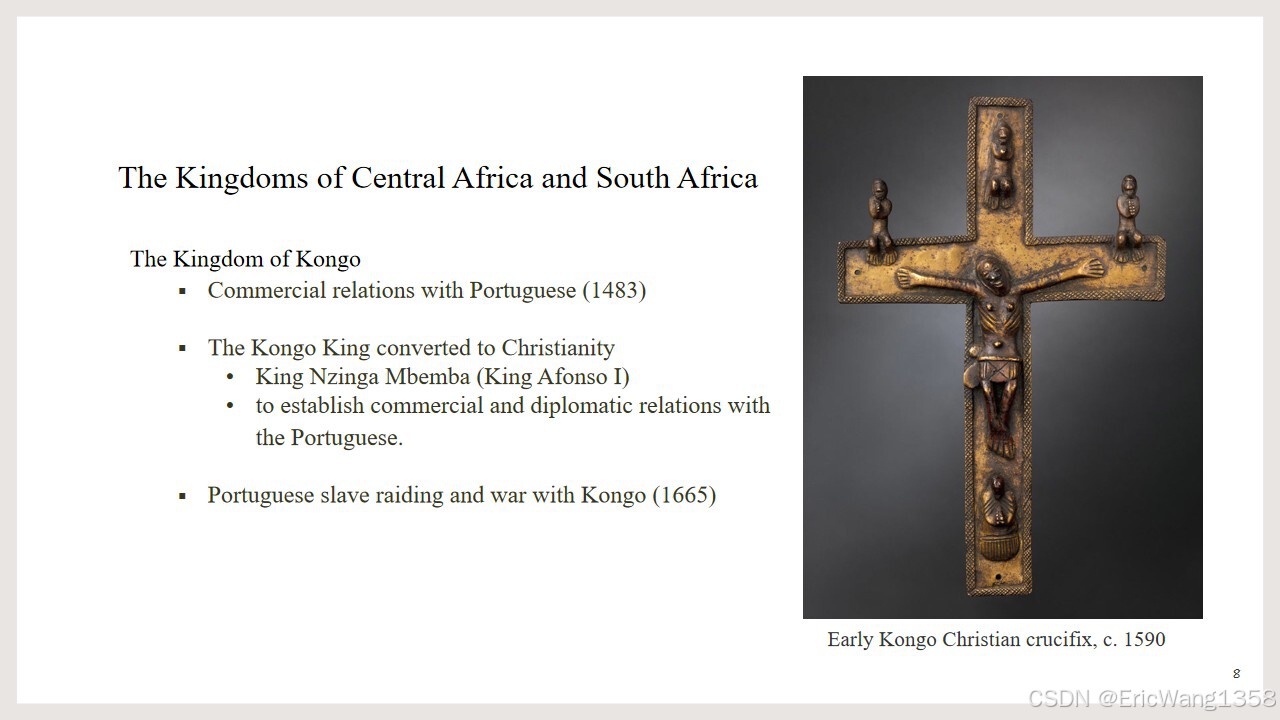
幻灯片 8:
这张幻灯片介绍了刚果王国和南部非洲的一些王国。通俗来说,刚果王国在1483年与葡萄牙建立了商业关系,之后刚果国王恩齐加·姆本巴(即阿丰索一世)皈依基督教,旨在与葡萄牙建立更紧密的外交和商业关系。然而,葡萄牙的奴隶掠夺行动与刚果的反抗最终导致了冲突。
从专业角度看,刚果王国与葡萄牙的关系反映了当时非洲与欧洲之间的复杂互动。葡萄牙希望利用刚果丰富的资源和劳动力,而刚果则试图通过与葡萄牙的合作实现经济和外交上的双赢。然而,葡萄牙对奴隶贸易的依赖与刚果的文化和社会结构产生了冲突,最终导致了双方之间的战争。
Slide 8:
This slide discusses the Kingdom of Kongo and other central and southern African kingdoms. Simply put, the Kingdom of Kongo established commercial relations with Portugal in 1483, and the Kongo King Nzinga Mbemba (King Afonso I) converted to Christianity in order to establish closer diplomatic and commercial relations with the Portuguese. However, Portuguese slave raiding and the conflict with Kongo eventually led to war.
From a professional perspective, the relationship between the Kingdom of Kongo and Portugal reflects the complex interactions between Africa and Europe at the time. Portugal sought to exploit the rich resources and labor of Kongo, while Kongo attempted to secure economic and diplomatic benefits through cooperation. However, Portugal’s reliance on the slave trade clashed with Kongo’s cultural and social structures, leading to conflict between the two powers.

幻灯片 9:
这张幻灯片介绍了安哥拉王国(也叫恩东戈王国)。通俗来说,葡萄牙在1575年在安哥拉建立了一个殖民地,名为罗安达,这是葡萄牙在撒哈拉以南非洲的第一个殖民地。恩金扎女王领导了抵抗葡萄牙的运动,这使安哥拉成为第一个被葡萄牙殖民的撒哈拉以南非洲地区。
从专业角度看,葡萄牙的征服标志着欧洲殖民主义在非洲的进一步扩张。女王恩金扎领导的抵抗反映了非洲各国在面对欧洲扩张时的坚持和反抗精神。安哥拉的征服不仅改变了当地的政治格局,还促进了葡萄牙与其他非洲国家的商业和军事互动。
Slide 9:
This slide discusses the Kingdom of Ndongo (also known as the Kingdom of Angola). Simply put, Portugal established a colony at Luanda in 1575, making it the first European colony in Sub-Saharan Africa. Queen Nzinga led the resistance against the Portuguese, which made Angola the first European colony in Sub-Saharan Africa.
From a professional perspective, the Portuguese conquest marked the further expansion of European colonialism in Africa. The resistance led by Queen Nzinga reflects the resilience and resistance of African states against European expansion. The conquest of Angola not only altered the local political landscape but also facilitated commercial and military interactions between Portugal and other African states.

幻灯片 10:
这张幻灯片介绍了南非的大津巴布韦王国以及欧洲在南非的到来。通俗来说,大津巴布韦是南非历史上一个重要的王国,其遗址至今仍在研究中。荷兰人在1652年在开普敦建立了一个贸易站点,这标志着欧洲殖民势力在南非的开始。
从专业角度看,大津巴布韦的遗址体现了南部非洲早期的强大文化和经济结构。荷兰人的到来则开启了南非历史上一个新的殖民时代,通过建立贸易站点和大规模的欧洲定居者移民,改变了南非的社会、政治和经济环境。
Slide 10:
This slide discusses the Great Zimbabwe Kingdom and the arrival of Europeans in South Africa. Simply put, Great Zimbabwe was an important kingdom in southern Africa, and its ruins are still the subject of study today. The Dutch established a trading post at Cape Town in 1652, marking the beginning of European colonial influence in southern Africa.
From a professional perspective, the ruins of Great Zimbabwe reflect the powerful cultural and economic structures of early southern Africa. The arrival of the Dutch marked the beginning of a new colonial era in South Africa, and by establishing trading posts and large-scale European settlement, the Dutch altered the social, political, and economic landscape of South Africa.

幻灯片 11:
这张幻灯片讲述了伊斯兰教和基督教在早期现代非洲的传播。通俗来说,基督教和伊斯兰教在地中海地区的长期冲突为西非与大西洋世界的联系奠定了基础。伊斯兰教在撒哈拉以南非洲的传播深受西非和东非重要商业中心如廷布克图和杰内的影响。阿拉伯语在这些地区的传播促进了文化和贸易的交流。
从专业角度看,基督教与伊斯兰教的冲突对非洲的宗教景观产生了深远影响。伊斯兰教在西非的商业中心扎根,与贸易路线和跨撒哈拉的商业活动紧密相连。随着阿拉伯语的传播,伊斯兰教成为学术和法律的核心,而基督教则主要通过葡萄牙的传教士影响南部非洲地区。
Slide 11:
This slide discusses the spread of Islam and Christianity in early modern Africa. Simply put, the long-standing conflict between Christianity and Islam in the Mediterranean region played a crucial role in opening up Western Africa to the Atlantic World. Islam spread in sub-Saharan Africa through commercial centers in West and East Africa, such as Timbuktu and Jenne. The spread of the Arabic language facilitated cultural and trade exchanges.
From a professional perspective, the conflict between Christianity and Islam had profound effects on the religious landscape of Africa. Islam took root in commercial centers in West Africa, closely linked to trade routes and Trans-Saharan commerce. As Arabic spread, Islam became central to scholarship and law, while Christianity was mainly spread through Portuguese missionaries in Southern Africa.

幻灯片 12:
这张幻灯片展示了伊斯兰教在非洲的传播,特别是从7世纪到18世纪的传播路径。通俗来说,穆斯林商人在7至8世纪通过撒哈拉沙漠进行贸易,并将伊斯兰教传入撒哈拉以南的地区。伊斯兰教通过尼罗河流域和撒哈拉南部的帝国逐渐在非洲大陆传播开来。
从专业角度看,伊斯兰教的传播不仅仅是宗教信仰的扩展,它伴随着跨撒哈拉和沿海的商业活动,深刻影响了非洲的政治、社会和经济结构。尤其是在富尔贝人(Fulani)和巴卡拉阿拉伯人(Baqqara Arabs)等群体的推动下,伊斯兰教的严格版本在一些地区得到了更为广泛的采纳。
Slide 12:
This slide shows the spread of Islam in Africa from the 7th to the 18th century. Simply put, Muslim merchants crossed the Sahara Desert in the 7th and 8th centuries, bringing Islam to sub-Saharan regions. Islam gradually spread across the African continent through Sudanese empires and the Nile River region.
From a professional perspective, the spread of Islam was not just a religious expansion but also tied to commercial activities across the Sahara and along coastal routes, which deeply influenced Africa’s political, social, and economic structures. With the movement of groups like the Fulani and Baqqara Arabs, the stricter forms of Islam became more widely adopted in certain regions.

幻灯片 13:
这张幻灯片讨论了伊斯兰教与本土信仰的融合,特别是在15世纪的非洲。通俗来说,很多地方的伊斯兰教与传统的本土信仰发生了混合,产生了被一些虔诚的穆斯林认为“不纯洁”的合成伊斯兰教。尤其是在富尔贝人(Fulani)中,伊斯兰化的过程变得更加严格,他们开始进行军事征战以建立伊斯兰国家。
从专业角度看,富尔贝人和其他地区的伊斯兰教改革者试图消除这些“合成伊斯兰教”的做法,推崇更加严格的宗教实践。这些军事行动不仅仅是宗教改革的体现,它们还在非洲的政治和社会结构中引发了变革,推动了伊斯兰教教义在更广泛地区的传播。
Slide 13:
This slide discusses how Islam blended with indigenous beliefs, particularly in 15th-century Africa. Simply put, Islam in many areas mixed with traditional indigenous beliefs, leading to a form of syncretic Islam that was considered "impure" by devout Muslims. Particularly among the Fulani, the process of Islamization became more strict, with military campaigns aimed at establishing Islamic states.
From a professional perspective, the Fulani and other Islamic reformers sought to purge these syncretic practices and advocated for a stricter form of Islam. These military campaigns were not just religious reforms; they also triggered political and social changes in Africa, promoting the wider spread of Islamic teachings across larger regions.
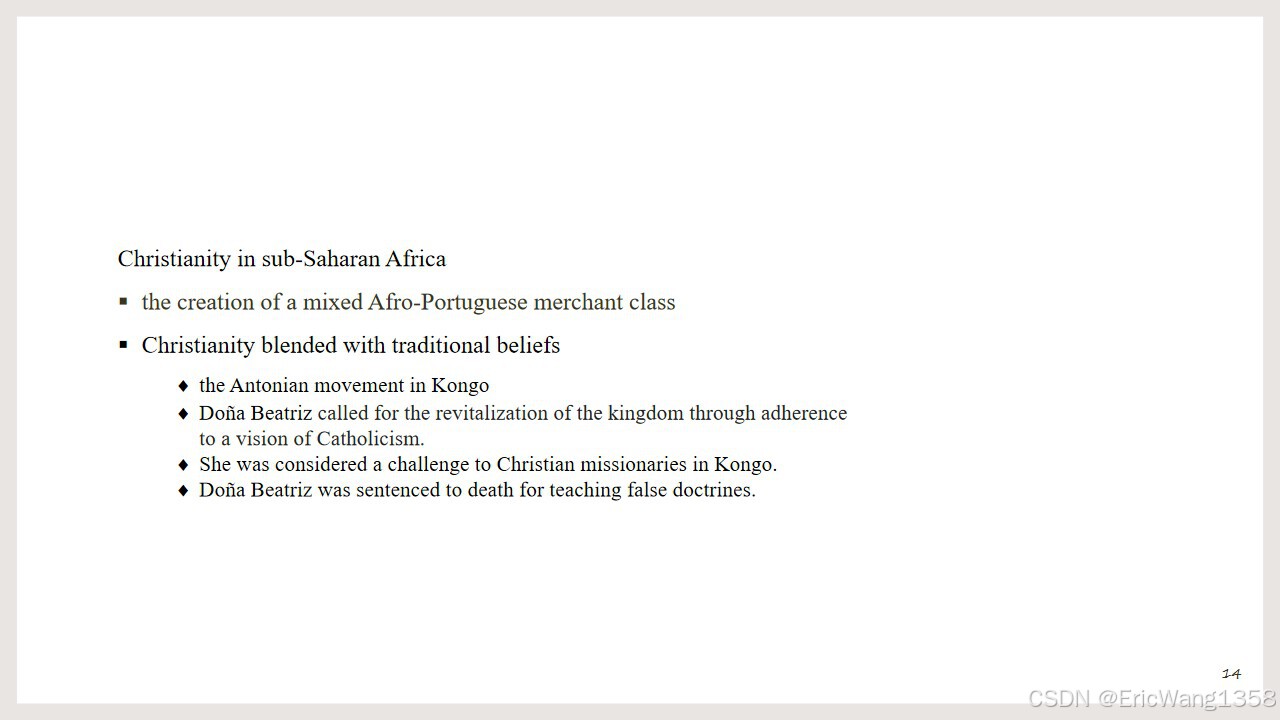
幻灯片 14:
这张幻灯片介绍了基督教在撒哈拉以南非洲的传播,尤其是葡萄牙的影响。通俗来说,葡萄牙通过建立混合的非洲-葡萄牙商人阶层,将基督教带到非洲,并在当地与传统信仰融合。安托尼亚运动是其中的一个例子,多娜·贝阿特里斯提倡通过信奉天主教来复兴刚果王国,但她因此被认为挑战了基督教传教士,最终被处死。
从专业角度看,安托尼亚运动反映了葡萄牙传教士在非洲的挑战。多娜·贝阿特里斯推崇一种本土化的天主教版本,强调与刚果的传统信仰结合。她的教义挑战了传统的天主教权威,并在刚果社会中引起了激烈的反响,最终导致了她的死亡。
Slide 14:
This slide introduces the spread of Christianity in sub-Saharan Africa, particularly through Portuguese influence. Simply put, Portugal brought Christianity to Africa by establishing a mixed Afro-Portuguese merchant class, blending Christianity with indigenous beliefs. One example of this is the Antonian Movement, where Doña Beatriz called for the revitalization of the Kingdom of Kongo through adherence to Catholicism. She was considered a challenge to Christian missionaries and was eventually sentenced to death for teaching false doctrines.
From a professional perspective, the Antonian Movement reflects the challenges faced by Portuguese missionaries in Africa. Doña Beatriz advocated for a localized version of Catholicism, one that integrated traditional Kongo beliefs. Her teachings challenged the authority of the Catholic Church, creating a significant controversy within Kongo society, ultimately leading to her execution.
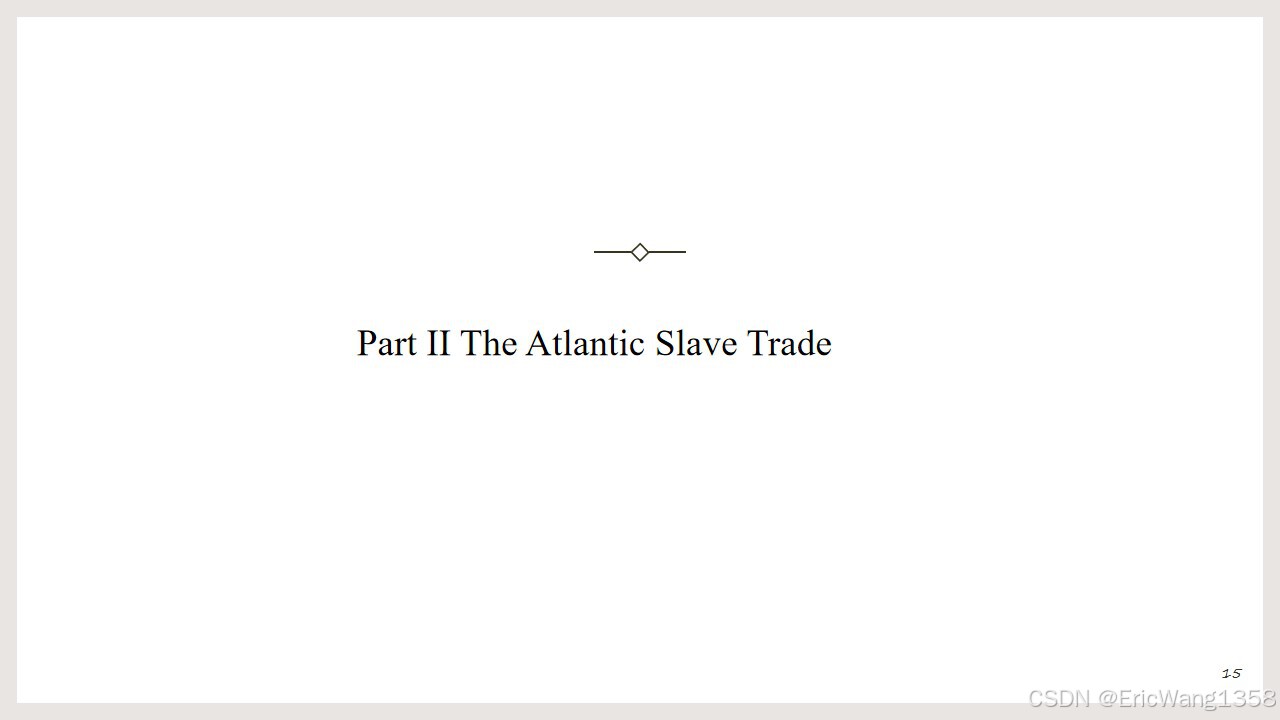
幻灯片 15:
这张幻灯片标志着大西洋奴隶贸易的第二部分开始。通俗来说,大西洋奴隶贸易是指从16世纪到19世纪,非洲奴隶被从撒哈拉以南的非洲运送到美洲的过程。这个过程中,欧洲殖民者通过建立殖民地并依靠强制劳动来获得丰富的农产品和矿产资源。
从专业角度来看,大西洋奴隶贸易不仅是一场巨大的强制迁徙和劳动力交换,还对全球经济产生了深远影响。这种经济模式带动了跨大西洋的商品、货币和奴隶流动,影响了美洲、非洲以及欧洲的社会结构。
Slide 15:
This slide marks the beginning of Part II: The Atlantic Slave Trade. Simply put, the Atlantic Slave Trade refers to the process in which African slaves were transported from sub-Saharan Africa to the Americas from the 16th century to the 19th century. European colonists established colonies and relied on forced labor to acquire abundant agricultural and mineral resources during this time.
From a professional perspective, the Atlantic Slave Trade was not just a massive forced migration and labor exchange; it also had a profound impact on the global economy. This economic system drove the movement of goods, money, and slaves across the Atlantic, affecting the social structures of the Americas, Africa, and Europe.

幻灯片 16:
这张幻灯片讲述了奴隶贸易的基础。通俗来说,奴隶在非洲很多社会中长期存在,主要来源是战争俘虏、罪犯或被驱逐的个人。在非洲的奴隶贸易中,奴隶被视为财富的象征,特别是在撒哈拉以南地区。
从专业角度看,伊斯兰奴隶贸易和非洲本土的奴隶制度在奴隶贸易的扩展中起到了基础性作用。伊斯兰商人通过撒哈拉沙漠,将非洲奴隶带到地中海和中东地区,促进了这类奴隶交易的扩展。随着1450年后欧洲对现有贸易网络的拓展,大西洋奴隶贸易逐渐发展起来,并成为全球贸易系统的重要组成部分。
Slide 16:
This slide discusses the foundations of the slave trade. Simply put, slavery had been prevalent in many African societies before the Trans-Atlantic slave trade, with slaves typically coming from war captives, criminals, or expelled individuals. In Africa, slavery was often seen as a symbol of wealth, especially in Sub-Saharan regions.
From a professional perspective, the Islamic slave trade and the indigenous African slave system played a foundational role in the expansion of slavery. Muslim merchants traded African slaves across the Sahara to the Mediterranean and the Middle East, facilitating the spread of this trade. After 1450, Europeans tapped into these existing trade networks and expanded commerce in slaves into the Atlantic world, which eventually became a central part of the global trade system.

幻灯片 17:
这张幻灯片展示了中世纪非洲主要奴隶贸易路线的地图。通俗来说,非洲的奴隶贸易在大西洋奴隶贸易之前,已经通过撒哈拉沙漠和海上路线进行了多次交易。奴隶主要从撒哈拉以南的非洲地区被运送到地中海、阿拉伯世界和中东。
从专业角度来看,在大西洋奴隶贸易发展的初期,非洲的奴隶贸易已经在非洲内部和对外的网络中运行。刚果王国、加纳帝国等国家的奴隶和其他商品通过这些路线流动,形成了复杂的贸易网络。这些网络为后来葡萄牙、西班牙和其他欧洲列强的参与提供了基础。
Slide 17:
This slide presents a map of the main slave trade routes in Medieval Africa, before the development of the Trans-Atlantic slave trade. Simply put, African slave trade existed before the Trans-Atlantic trade, with slaves primarily being transported from Sub-Saharan Africa to the Mediterranean, Arab world, and the Middle East through the Sahara and maritime routes.
From a professional perspective, before the development of the Atlantic Slave Trade, African slave trade had already been operating within and outside Africa through established networks. Slaves and other goods from empires such as the Kingdom of Kongo and the Ghana Empire moved through these routes, forming complex trade networks. These networks laid the groundwork for later European powers like Portugal and Spain to engage in the trade.

幻灯片 18:
这张幻灯片讨论了大西洋奴隶贸易的运作机制。通俗来说,大西洋奴隶贸易是世界历史上最复杂的经济活动之一,是全球最大规模的跨洋移民。它不仅促进了人力和货物的运输,还促进了欧洲资本在国际贸易中的投资。
从专业角度来看,大西洋奴隶贸易推动了大规模的跨洋航运,欧洲商人在这个过程中占据了重要角色。这个贸易的运作机制包括了大量的奴隶运输、货物交换和资本流动,成为了工业革命之前全球最重要的经济活动之一。大西洋奴隶贸易对美洲、非洲和欧洲的社会、经济和政治结构产生了深远的影响。
Slide 18:
This slide discusses the mechanisms of the Atlantic Slave Trade. Simply put, the Atlantic Slave Trade was one of the most complex economic enterprises in world history and represented the largest transoceanic migration at the time. It not only promoted the transportation of people and goods but also attracted significant European capital invested in international commerce.
From a professional perspective, the Atlantic Slave Trade drove large-scale transoceanic shipping, with European merchants playing a central role. The operational mechanisms of this trade included vast amounts of slave transportation, goods exchange, and capital flow, making it one of the most significant economic activities in the world before the Industrial Revolution. The Atlantic Slave Trade had a profound impact on the social, economic, and political structures of the Americas, Africa, and Europe.

幻灯片 19:
这张幻灯片展示了葡萄牙对西非的早期探索及其对奴隶贸易的影响。通俗地说,葡萄牙的探索主要是为了获取西非的黄金资源。早期葡萄牙与刚果帝国的奴隶贸易合作,也为他们控制贸易路线和资源提供了帮助。
从专业角度来看,葡萄牙通过政府授权的税收、补贴和垄断合同在早期主导了奴隶贸易。葡萄牙的这些探索行为不仅与黄金开采相关,还为后来的大西洋奴隶贸易奠定了基础,成为全球奴隶贸易体系的先驱。
Slide 19:
This slide shows Portugal's early exploration in West Africa and its influence on the slave trade. Simply put, Portugal's exploration was primarily to access the gold-producing areas of West Africa. Early slave trade with the Kingdom of Kongo helped them control trade routes and resources.
From a professional perspective, Portugal dominated the early slave trade through state-supported actions such as taxation, subsidization, and monopoly contracts. These explorations were not only related to gold mining but also laid the groundwork for the later Trans-Atlantic slave trade, making Portugal a pioneer in the global slave trade system.
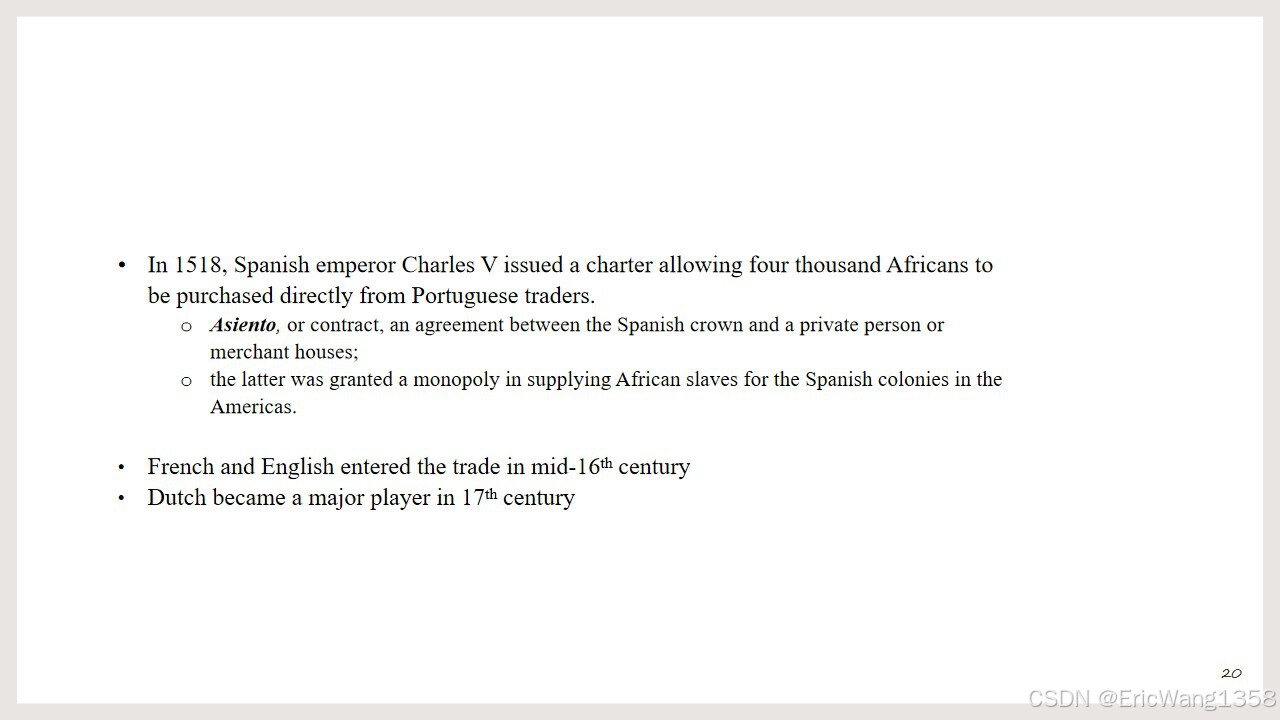
幻灯片 20:
这张幻灯片描述了Asiento的概念及其在西班牙殖民地奴隶贸易中的作用。通俗来说,Asiento是一种合同,西班牙皇帝允许葡萄牙商人直接向西非购买奴隶,提供了葡萄牙对西班牙殖民地的垄断供应权。
从专业角度看,1518年西班牙皇帝查理五世颁布了这一法令,允许葡萄牙商人为西班牙殖民地提供4,000名非洲奴隶。这种合同为葡萄牙商人提供了对美洲市场的控制权,并且后续法国、英国和荷兰等欧洲国家也在16世纪中期进入这一市场,推动了奴隶贸易的全球化。
Slide 20:
This slide describes the concept of Asiento and its role in the Spanish colonial slave trade. Simply put, Asiento was a contract that allowed Portuguese traders to directly purchase slaves from West Africa for Spanish colonies, granting Portugal a monopoly on supplying slaves to Spanish America.
From a professional perspective, in 1518, Spanish Emperor Charles V issued a charter allowing Portuguese traders to supply 4,000 African slaves to Spanish colonies. This contract provided Portuguese merchants with control over the American market. Later, France, England, and the Netherlands entered the market in the mid-16th century, leading to the globalization of the slave trade.

幻灯片 21:
这张幻灯片展示了三角贸易的基本框架。通俗来说,三角贸易是大西洋奴隶贸易的主要商业模式,涉及三个关键环节:第一,从欧洲出口制造品到非洲交换奴隶;第二,将奴隶运送到美洲;第三,将美洲的商品(如糖、烟草、酒等)运回欧洲。
从专业角度看,三角贸易形成了一个跨大西洋的经济网络,欧洲制造的商品和非洲的奴隶、来自美洲的资源共同构成了全球经济的基础。这一贸易不仅促进了奴隶贸易,还加深了各大洲之间的经济和文化联系。
Slide 21:
This slide outlines the basic framework of the Triangular Trade. Simply put, Triangular Trade was the main commercial system for the Atlantic Slave Trade, involving three key stages: First, European manufactured goods were exported to Africa in exchange for slaves; second, slaves were transported to the Americas; and third, goods from the Americas (such as sugar, tobacco, and rum) were sent back to Europe.
From a professional perspective, Triangular Trade formed a transatlantic economic network, with European goods, African slaves, and resources from the Americas forming the basis of the global economy. This trade not only facilitated the slave trade but also deepened economic and cultural connections between continents.

幻灯片 22:
这张幻灯片讲述了中途航程(Middle Passage)的情况。通俗来说,中途航程是指奴隶们被强行运送到美洲的过程,这一过程常常充满暴力、疾病和极端的恶劣条件。
从专业角度看,中途航程不仅是大西洋奴隶贸易的核心环节,也是最具悲剧性的部分。奴隶在拥挤、肮脏的船舱中度过漫长的航程,许多人因疾病、营养不良和虐待而死。1788年,船舶Brookes的图示展示了奴隶如何被紧密地堆积在船舱中,这种非人道的运输方式导致了大量死亡和反抗。
Slide 22:
This slide discusses the Middle Passage, the forced journey of enslaved Africans across the Atlantic to the Americas. Simply put, the Middle Passage was often filled with violence, disease, and harsh conditions for the enslaved individuals.
From a professional perspective, the Middle Passage was not only the core segment of the Atlantic Slave Trade but also the most tragic part. Slaves were tightly packed in filthy, cramped conditions during the long journey, with many dying from disease, malnutrition, and abuse. In 1788, a diagram of the slave ship Brookes illustrated how enslaved Africans were stored below deck, showing the inhumane conditions that led to widespread death and rebellion.
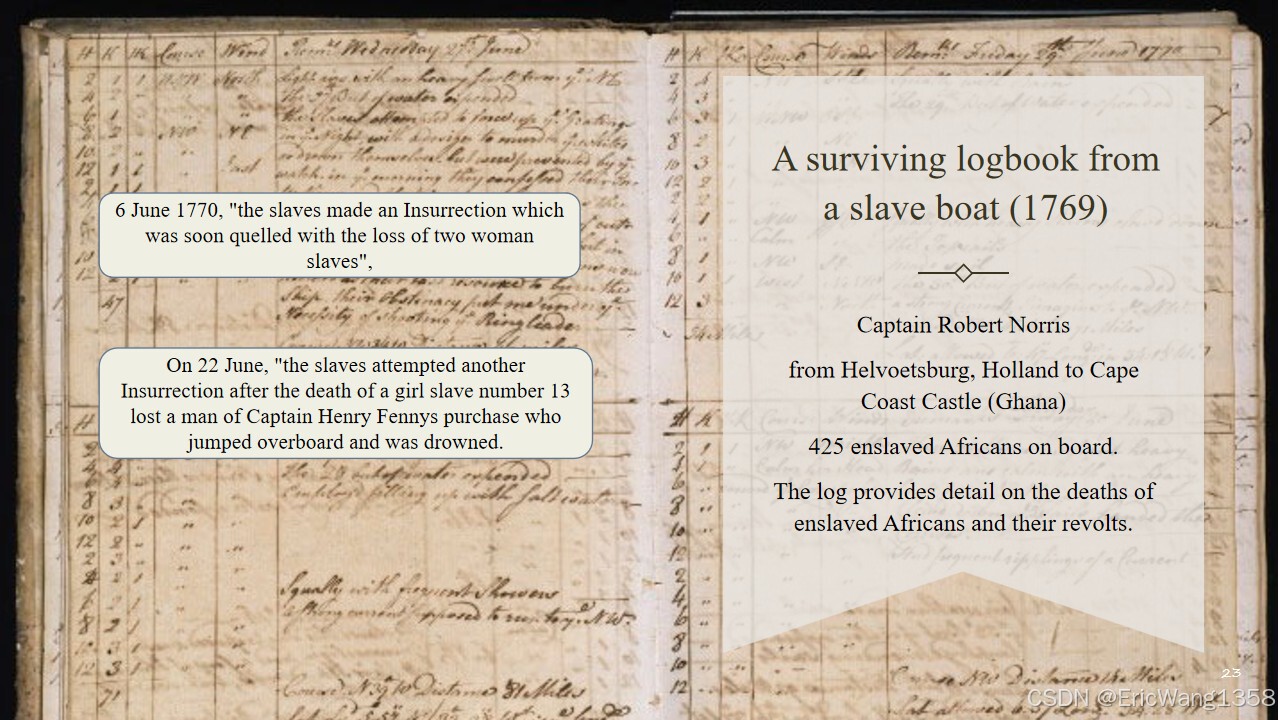
幻灯片 23:
这张幻灯片展示了来自一艘奴隶船的生存日志。通俗来说,这份日志记录了奴隶船上的暴动和奴隶的死亡情况,反映了奴隶在途中面临的极度压迫和苦难。
从专业角度看,这份日志提供了宝贵的历史见证,揭示了奴隶贸易中的暴力、反抗和奴隶的死亡。日志详细记录了在奴隶船上的斗争与抵抗行为,这种抵抗体现了奴隶对自己命运的反抗和对自由的渴望。
Slide 23:
This slide presents a surviving logbook from a slave boat. Simply put, the log records the revolts and deaths of slaves aboard the ship, reflecting the extreme oppression and suffering faced by enslaved individuals during the journey.
From a professional perspective, this log provides valuable historical evidence, revealing the violence, resistance, and deaths within the slave trade. The log details the struggles and acts of resistance aboard the slave ship, showcasing the slaves' defiance against their fate and their longing for freedom.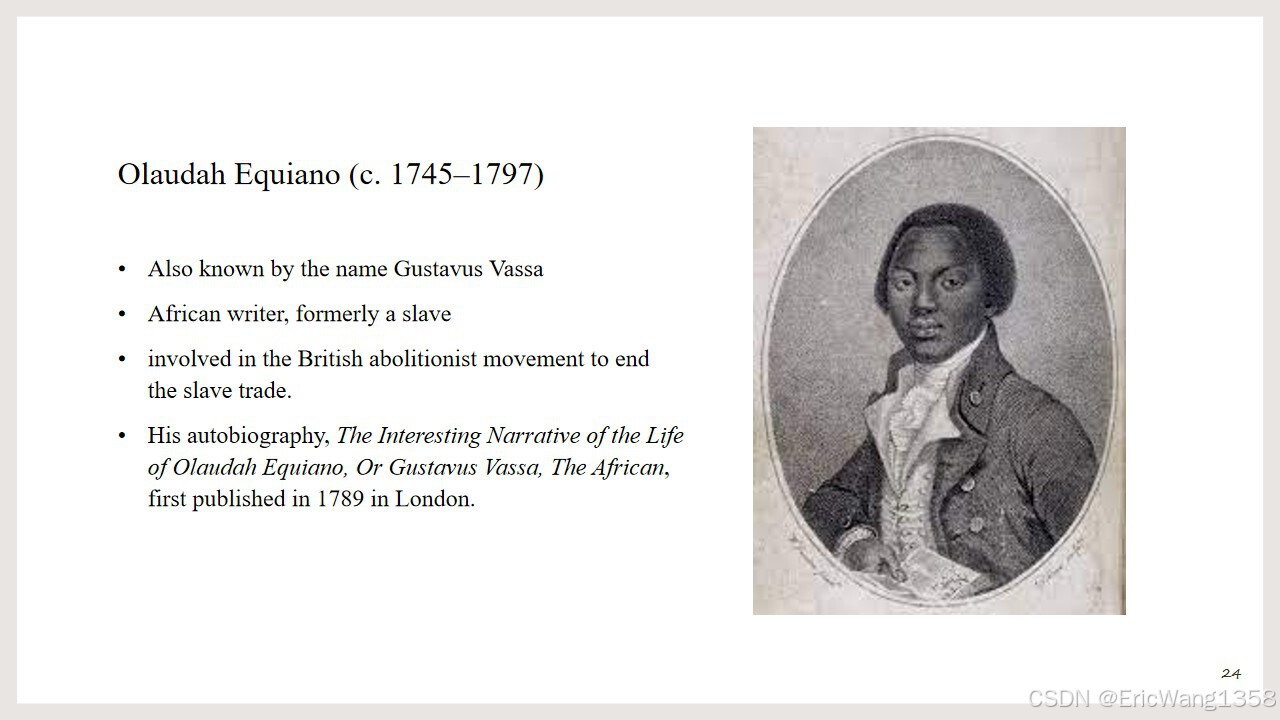
幻灯片24: 这张幻灯片介绍了奥劳达·奎亚诺(Olaudah Equiano),他出生于1745年,是一位非洲作家和废奴主义者,曾被奴役。奎亚诺的自传《奥劳达·奎亚诺生平趣事》首次出版于1789年,书中讲述了他从奴隶到自由人的奋斗故事,并为废奴运动做出了贡献。通过这本书,他不仅阐述了奴隶制的残酷,也让更多人认识到奴隶的苦难,从而推动了英国废奴运动的发展。
Slide 24: This slide introduces Olaudah Equiano (1745–1797), an African writer and former slave, who is also known by the name Gustavus Vassa. His autobiography, The Interesting Narrative of the Life of Olaudah Equiano, Or Gustavus Vassa, The African, was first published in 1789 in London. In this book, he narrates his journey from being enslaved to achieving freedom, and his active participation in the abolitionist movement. His work highlighted the brutality of slavery and contributed to raising awareness, thus playing an essential role in the British abolitionist movement.

幻灯片25: 这一幻灯片展示了奥劳达·奎亚诺的旅行路线。他出生在尼日利亚贝宁王国的厄博地区,并在11岁时被非洲奴隶贩子捕获。奎亚诺被多次转卖,最后落入非洲海岸,经历了奴隶贸易的痛苦。尽管他是一个奴隶,但他一生中去过许多地方,这是非常不寻常的,尤其是在奴隶的情况下。
Slide 25: This slide shows the travel itinerary of Olaudah Equiano. Born in 1745 in the Eboe region of the Kingdom of Benin (now Nigeria), Equiano was captured by African slave traders at the age of eleven. He was sold multiple times and eventually ended up by the African coast. Despite being a slave, he traveled to many places during his lifetime, which was very unusual for a slave, and his journey serves as a testament to the far-reaching effects of the transatlantic slave trade.

幻灯片26: 这张幻灯片展示了《新世界的非洲人》中的一部分内容。它来自于吉尔·勒波(Jill Lepore)编辑的《新世界的相遇:文件中的历史》一书。通过引用休·琼斯(Hugh Jones)的《弗吉尼亚的现状》一书的描述,我们可以看到当时殖民地奴隶的实际生活情况。这些描述反映了当时奴隶的社会地位以及他们在种植园中的艰苦生活。
Slide 26: This slide features an excerpt from Africans' New Worlds, edited by Jill Lepore, in Encounters in the New World: A History in Documents. It includes a passage from Hugh Jones' The Present State of Virginia, describing the conditions of African slaves living in the plantations. These descriptions give insights into the social status of slaves at the time and their harsh lives in the plantations, providing a historical context to the daily suffering endured by enslaved individuals in the colonies.

幻灯片27: 这张幻灯片显示了一张1754年的英国美洲种植园地图。这张地图展示了当时美洲大陆的种植园分布,反映了奴隶劳动在农业生产中的重要性。奴隶劳动力是支撑殖民地经济的基石,尤其是在以种植园为主的南方地区,奴隶的数量和使用方式直接影响了殖民地经济的运作。
Slide 27: This slide displays a map of British American plantations from 1754. The map shows the distribution of plantations across the American colonies, reflecting the importance of slave labor in agricultural production. Slaves were the backbone of the colonial economy, particularly in the southern regions where plantations were dominant. The number and use of slaves directly impacted the functioning of the colonial economy, demonstrating the integral role slavery played in the economic system of the time.

奴隶贸易对非洲的影响
奴隶贸易的数量
- 17世纪,奴隶的出口量显著增加,每年大约20,000人。
- 18世纪,奴隶到达的数量平均每年达到88,000人。
奴隶贸易的社会影响
- 奴隶贸易将大量劳动力从非洲转移到其他地区。非洲很多地区的劳动力人口大幅度减少,这使得许多传统的生产力和社会结构发生了巨大变化。
- 社会性别失衡:大量男性被强制送往新大陆,导致非洲很多地区性别比例失衡。
奴隶贸易的政治影响
- 以达荷美王国为例,达荷美的经历表明,奴隶贸易不仅仅影响了经济和社会,还对政治和军事带来了深远的影响。为了参与奴隶贸易,许多非洲国家之间的政治和军事局势发生了变化,导致了内部战争的增加。
Slide 28 Explanation:
The Impact of the Slave Trade in Africa
Volume of the Slave Trade
- In the 17th century, the export of slaves dramatically increased, averaging 20,000 per year.
- In the 18th century, the arrival of slaves in the Americas averaged 88,000 per year.
Social Effects of the Slave Trade
- The slave trade diverted a significant labor force from Africa to other lands. Many African societies saw a drastic reduction in their workforce, which led to major changes in traditional production systems and social structures.
- Sexual imbalance: A large number of men were forcibly taken to the Americas, leading to a gender imbalance in many parts of Africa.
Political Effects of the Slave Trade
- The experience of Dahomey, a West African kingdom, exemplifies how the slave trade influenced not only economic and social structures but also political and military dynamics. To engage in the slave trade, many African kingdoms had to change their political and military strategies, leading to an increase in internal conflicts.

























 被折叠的 条评论
为什么被折叠?
被折叠的 条评论
为什么被折叠?








